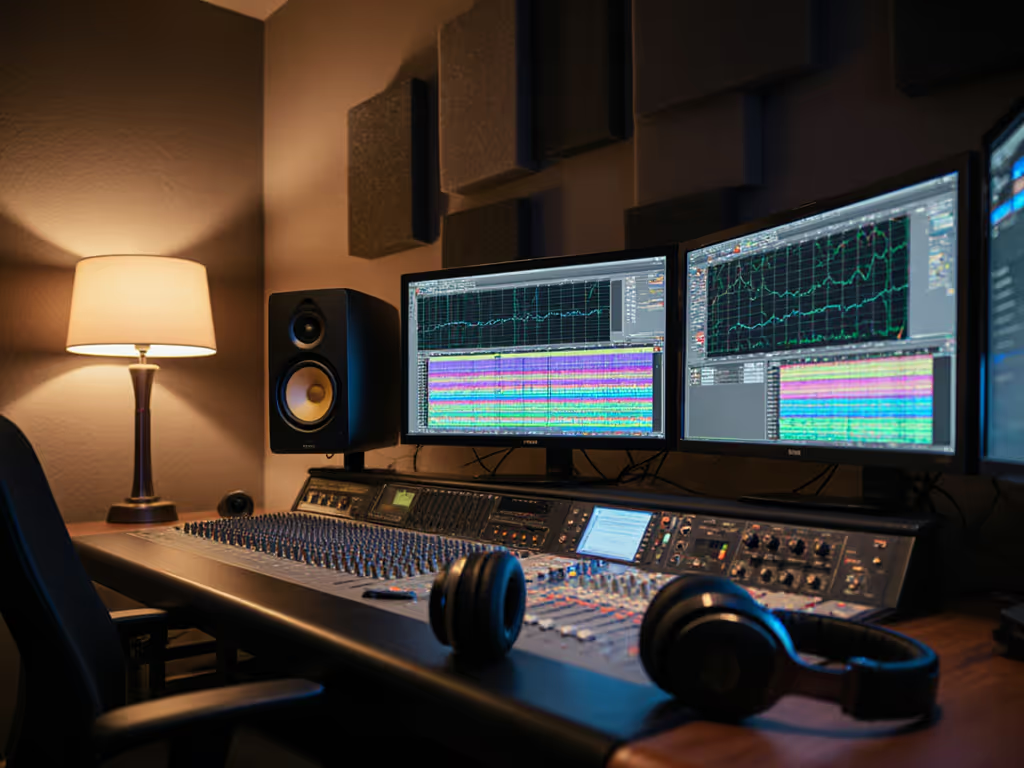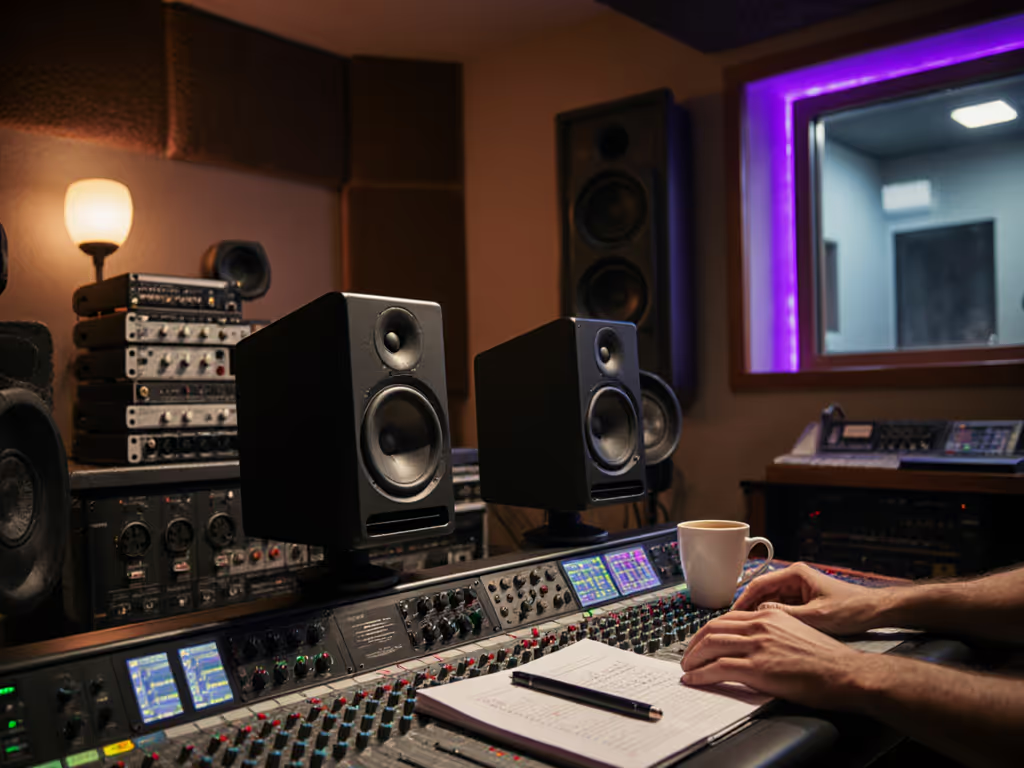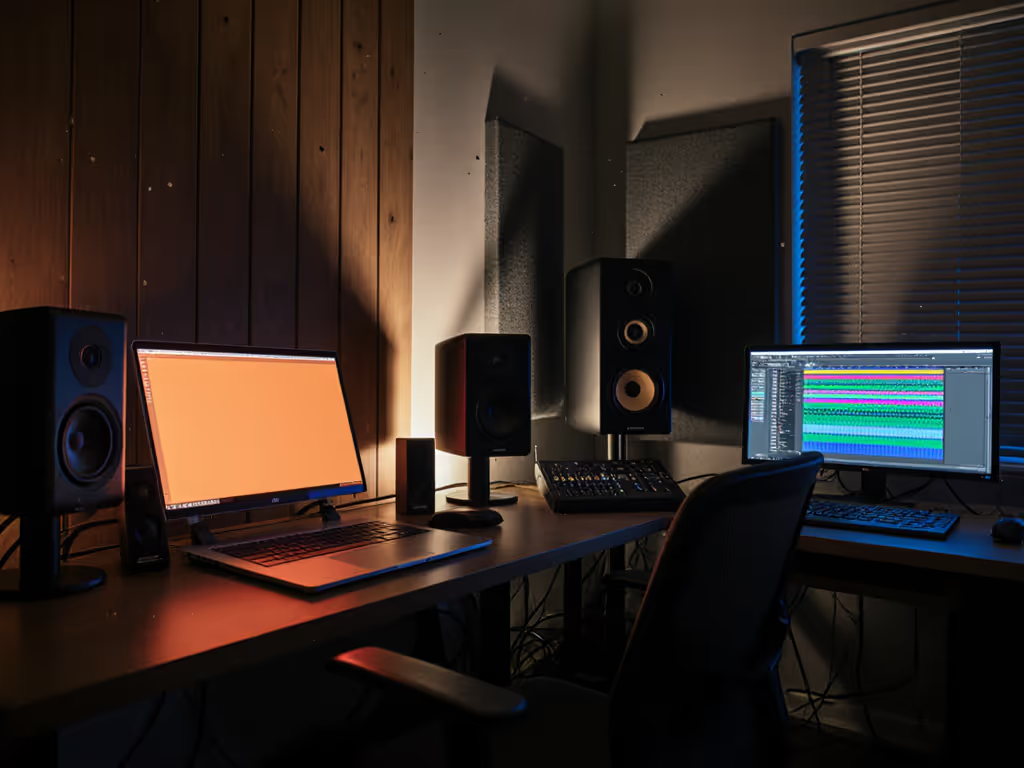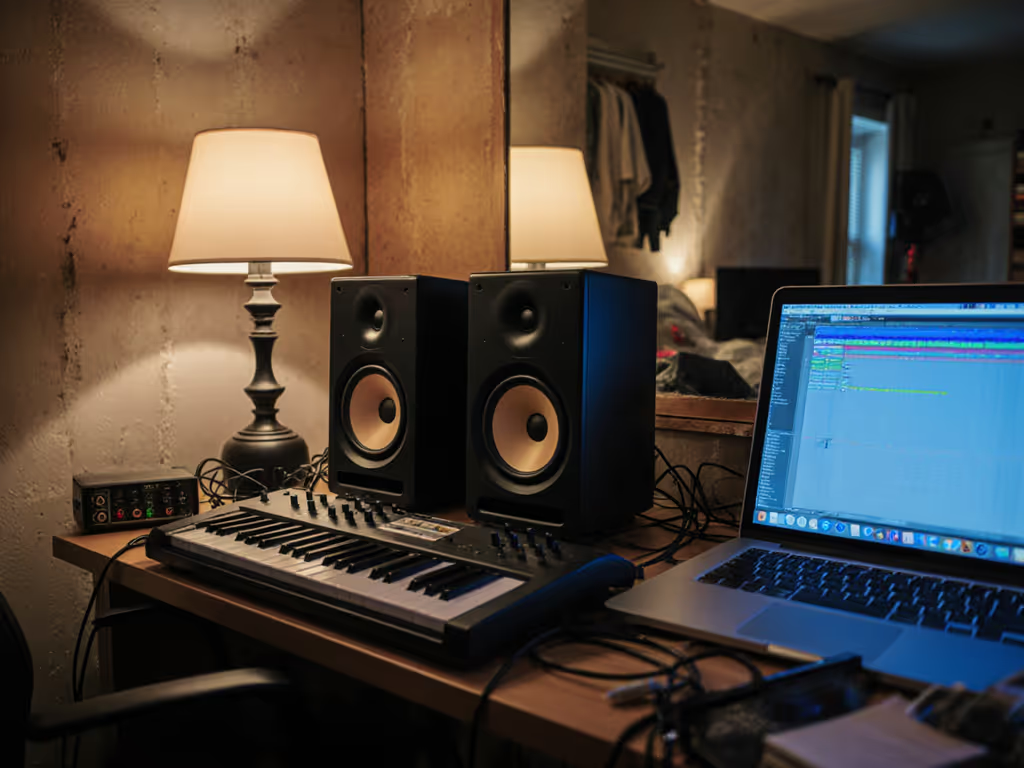
Coaxial Studio Monitors: Solve Sweet Spot Limitations?
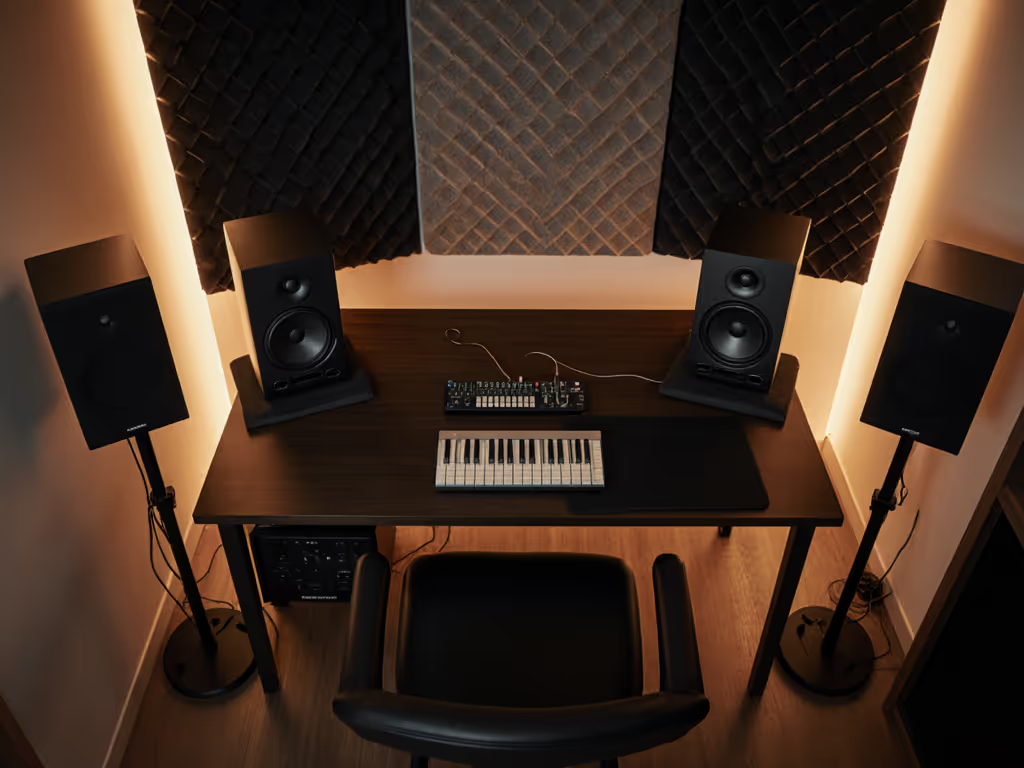
As you evaluate the best studio monitors for your cramped bedroom studio or cluttered desk setup, coaxial studio monitors present an intriguing proposition. Proponents claim they solve fundamental issues plaguing traditional two-way designs, especially the narrow sweet spot that frustrates bedroom creators working at one meter or less. But do they actually deliver better translation in your imperfect space? Let's cut through the hype with measurement data and real small-room physics.
Curves matter, but only as far as rooms allow.
What Problem Do Coaxial Studio Monitors Actually Solve?
Traditional two-way monitors position their tweeter above or below the woofer, creating a physical separation between sound sources. When frequencies overlap at the crossover point (typically 1.8-3 kHz), this separation causes phase interference that varies dramatically as you move your head, and even minor shifts change spectral balance. In small rooms where your head can't move more than 10cm without hitting a wall, this is particularly problematic.
Coaxial designs position the tweeter concentrically within the mid/woofer, creating a single acoustic center. This theoretically eliminates the vertical-axis phase interference that plagues conventional designs. But the real test comes in the one-meter reality check: how does this translate when your listening position is constrained by a desk, a wall, and neighbors demanding quiet after 10pm?
How Does Off-Axis Performance Actually Differ?
Let's examine the data. A typical two-way monitor shows significant response variation (±6dB) between 0° and 30° off-axis vertically, a lethal problem when your head moves slightly while tracking vocals. Horizontal dispersion is usually better, but room boundaries smear this anyway.
Coaxial designs show remarkable vertical consistency. At 2kHz (where crossovers often live), a quality coaxial maintains ±2dB between 0°-40° vertical off-axis. This explains why producers report more stable imaging when working seated at a cramped desk, so your head movements don't radically alter the tonal balance.
Graph-reading tip: When reviewing polar plots, focus on 1-5kHz vertical dispersion. ±3dB consistency here predicts usable sweet spot width. Beyond 5kHz, most rooms' reflections dominate anyway.
Do Coaxial Monitors Actually Fix My Desk Reflection Problems?
This is where many get misled. Coaxial geometry doesn't magically eliminate desk reflections (they still occur with the same physics). However, the controlled vertical dispersion characteristic of good coaxial designs reduces the energy bouncing off your work surface. For step-by-step placement and height tips to minimize desk reflections, see our ideal studio monitor height guide.
I once had a client who loved "sparkly" highs until I overlaid their room measurement showing a 200Hz desk-induced peak. The same principle applies: coaxial won't fix a reflective surface, but its stable off-axis response gives you more room to mitigate issues through placement.
Measurement caveat: Manufacturer polar plots rarely show what happens below 500Hz. Yet room modes dominate your low-end issues. Always supplement with independent low-frequency dispersion measurements.
Which Is Better for Small Rooms: Coaxial or 2-Way?
Let's establish clear thresholds based on your space:
- Under 10ft depth: Coaxial monitors typically outperform two-ways due to stable vertical dispersion compensating for limited listening position options
- Nearfield under 1m: Coaxial geometry shines where head movement is constrained by desks or walls
- Untreated rooms: Coaxial designs reduce vertical reflection issues, making them more forgiving of untreated first-reflection points
But they're not universally superior. Three-way coaxials (like some Kali Audio models) solve the "oscillating waveguide" problem of nesting tweeters within woofers, where the woofer's motion distorts the high-frequency output. In compact monitors, this is critical when you're working at 72dB SPL to avoid neighbor complaints. A woofer moving ±5mm at 80Hz creates audible air distortion on the tweeter output above crossover frequencies.
What Are The Real Coaxial Speaker Advantages For Bedroom Producers?
- Stable imaging within constrained head positions: No more "sweet spot" where your chin must sit precisely 15cm above the desk
- Reduced vertical reflection sensitivity: Less critical height positioning relative to desk surface
- More consistent spectral balance during editing: Critical when you're hunched over for 4-hour sessions
- Improved translation to vertical-listening devices: Matches earbud/headphone vertical axis better than conventional monitors
The key metric? Power response consistency. Controlled directivity and smooth power response make small rooms more predictable: a non-negotiable for creators who can't treat their spaces extensively.
What Should I Watch Out For With Coaxial Studio Monitors?
Not all coaxial designs are created equal. Beware of:
- Cheap concentric drivers that create high-frequency diffraction (check for smooth waveguide integration)
- Poor crossover integration between the coaxial mid/tweeter and separate woofer (listen for "tweeter drop-off" when moving vertically)
- Inadequate low-frequency control (many compact coaxials roll off earlier than comparable two-ways)
Precise definition: True coaxial monitors feature a common acoustic center where both drivers reproduce the crossover region simultaneously from the same point. Some "pseudo-coaxial" designs merely stack drivers vertically with minimal benefit.
How Should I Position Coaxial Monitors In My Tiny Space?
Forget traditional equilateral triangles. In sub-12ft rooms:
- Height matters less: Your ears can be slightly above/below axial height without drastic tonal shifts
- Distance to desk is critical: Maintain at least 15cm clearance beneath monitors (use isolation pads)
- Toe-in follows ear height: Point monitors toward your seated ear position, not parallel
- Lateral separation > front wall distance: In narrow rooms, prioritize wider spacing over ideal rear distance
The one-meter reality check applies doubly here: measure your actual listening position. Aim for 78-82dB SPL at 1kHz at your ears (measured with a Class 2 SPL meter) to simulate realistic working levels without disturbing neighbors.
What Makes Truly Good Studio Monitors For Compact Spaces?
Beyond the coaxial debate, look for these evidence-backed characteristics:
- Controlled directivity index (DI) between 1-5kHz (0.5-0.7 optimal for small untreated rooms)
- Vertical off-axis consistency within ±3dB at 30°
- Low group delay (<1.5ms) through crossover region
- Maximum SPL ≥85dB at 1m (for intermittent loud checks)
- Distortion <3% at 85dB SPL, 100Hz (critical for bass decisions)
"Good studio monitors" for small rooms prioritize smooth power response over maximum output. That client who loved the "exciting" highs? We cut desk height, corrected the 200Hz bump, and maintained clarity at safe listening levels, without constant revisions.
So, Which Is Better: Coaxial Or 2-Way For My Space?
Consider these objective decision points:
| Factor | Coaxial Advantage | 2-Way Advantage |
|---|---|---|
| Head position flexibility | ✔️ Wider vertical tolerance | ✖️ Narrow sweet spot |
| Desk reflection issues | ✔️ Reduced vertical smear | ✖️ Critical height positioning |
| Low-SPL clarity | ✔️ Stable crossover region | ✖️ Phase issues worsen at low volumes |
| Low-end extension | ✖️ Often limited in compact designs | ✔️ Better woofer integration |
| Cost per performance | ✖️ Typically 15-25% more expensive | ✔️ More budget options |
The truth? Quality matters more than topology. A well-designed two-way can outperform a poorly executed coaxial. But for bedroom producers with limited placement options and untreated vertical surfaces, coaxial designs provide meaningful advantages that manifest in fewer translation surprises.
Final Verdict: Do Coaxial Monitors Justify The Hype?
For most small-room creators, coaxial studio monitors deliver tangible benefits where it counts: stable imaging within constrained listening positions and reduced sensitivity to vertical reflections. They won't fix fundamental room issues, but they make your space more predictable with less tweaking.
Focus on measured performance in the 300Hz-5kHz range at actual listening distances (not anechoic specs). The best monitor for your small room delivers consistent spectral balance while you're actually working, not when sitting perfectly centered in an idealized space.
If you're evaluating your next pair of studio monitors, prioritize models with published power response data and verified low-SPL performance. Your mixes will thank you when they translate to earbuds, car systems, and club PAs without endless revision loops.
Further Exploration: Dive into the AES paper "Directivity Considerations for Small Room Monitoring" (2022) for the physics behind these recommendations. Better yet, find a local studio with different monitor types and conduct your own blind test at typical nearfield distances. Nothing beats your ears in your actual workflow, but understanding the engineering gives you the tools to make smarter choices.

